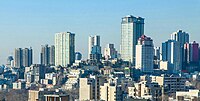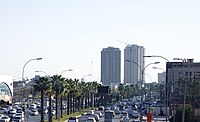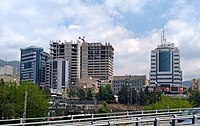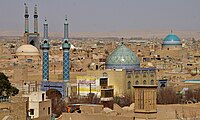فهرست پرجمعیتترین شهرها بر پایه جمعیت ایرانیتبار
برای تأییدپذیری کامل این مقاله به منابع بیشتری نیاز است. (ژوئیه ۲۰۲۳) |

مردمان ایرانیتبار یا مردمان ایرانی،[۱] قومیتی از تبار اقوام ایرانیزبان باستان هستند که به یکی از زبانهای ایرانی گویش میکنند.[۲][مبهم] این گروه قومی در سراسر فلات ایران، از هندوکش تا آناتولی مرکزی و از آسیای میانه تا دریای پارس، منطقهای که ایران بزرگ یا ایرانزمین نامیده میشود،[۳] پراکنده شدهاند.[مبهم]
مردمان ایرانیتبار شامل: فارسیزبانان، آذریها، مازندرانیها، تاتها، تالشها، گیلکها، کردها، بلوچها، پشتونها، لرها، لکها، تاجیکها، آسیها و غیره هستند. آذریها با وجود سخن گفتن به زبان ترکی آذربایجانی از نظر ژنتیکی از اقوام ایرانینژاد بهشمار میروند.[۴] تا پیش از حملهٔ مغول به ایران، مردم آذربایجان به زبانی ایرانی که آن را زبان آذری مینامید، سخن میگفتهاند.[۵][۶][۷] هنوز هم میتوان باقیمانده این زبان را در همه جای آذربایجان ایران و جمهوری آذربایجان یافت. زبان ترکی در سدههای پس از پاگیری اسلام در ایران، بر اثر مهاجرت تدریجی و متمادی ایلهای ترک، بهویژه در آسیای صغیر جایگزین زبانهای هند و اروپایی رایج در این منطقه شدهاست.
در این مقاله شهرهایی که دارای جمعیت بومی قابل توجه ایرانیتبار هستند فهرست شدهاند.[۸]
بر پایه جمعیت
[ویرایش]بر پایه کشور
[ویرایش]| شهر | کشور | جمعیت | زبان بیشینه | تصویر |
|---|---|---|---|---|
| تهران | ۸٬۶۹۳٬۷۰۶ | فارسی | 
| |
| کابل | ۴٬۶۳۵٬۰۰۰ | فارسی | 
| |
| باکو | ۲٬۳۷۴٬۰۰۰ | ترکی آذربایجانی | 
| |
| پیشاور | ۱٬۹۷۰٬۰۴۲ | پشتو | 
| |
| دیاربکر | ۹۳۰٬۲۶۶ | کردی | 
| |
| اربیل | ۸۵۲٬۵۰۰ | کردی | 
| |
| دوشنبه | ۷۷۸٬۵۰۰ | فارسی | 
| |
| سمرقند | ۵۰۴٬۴۲۳ | فارسی | 
| |
| ولادیقفقاز | ۳۱۱٬۶۹۳ | آسی | 
| |
| قامشلی | ۱۸۴٬۲۳۱ | کردی | 
| |
| تسخینوالی | ۳۰٬۰۰۰ | آسی | 
| |
| تاشکورگان | ۸٬۹۱۹ | پامیری | 
|
بر پایه زبان بیشینه
[ویرایش]| شهر | کشور | جمعیت | زبان بیشینه | تصویر |
|---|---|---|---|---|
| تهران | ۸٬۶۹۳٬۷۰۶ | فارسی | 
| |
| باکو | ۲٬۳۷۴٬۰۰۰ | ترکی آذربایجانی | 
| |
| پیشاور | ۱٬۹۷۰٬۰۴۲ | پشتو | 
| |
| دیاربکر | ۱٬۵۸۱٬۲۰۵ | کردی | 
| |
| کویته | ۱٬۱۰۳٬۸۲۰ | پشتو و بلوچی | 
| |
| کرمانشاه | ۹۴۶٬۶۵۱ | کردی، فارسی و دیگر گویشوران | 
| |
| رشت | ۶۷۹٬۹۹۵ | گیلکی | 
| |
| خرمآباد | ۳۷۳٬۴۱۶ | لری و لکی | 
| |
| ولادیقفقاز | ۳۱۱٬۶۹۳ | آسی | 
| |
| ساری | ۳۰۹٬۸۲۰ | مازنی | 
| |
| سیورک | ۱۲۰٬۵۵۶ | کردی | 
| |
| تاکستان | ۸۰٬۲۹۹ | تاتی | 
| |
| لار | ۶۲٬۰۴۵ | لارستانی | 
| |
| هشتپر | ۵۴٬۱۷۸ | تالشی | 
| |
| خاروغ | ۲۸٬۹۰۰ | پامیری | 
|
جستارهای وابسته
[ویرایش]منابع
[ویرایش]- ↑ R.N Frye, "IRAN v. PEOPLES OF IRAN" in Encyclopædia Iranica. "In the following discussion of “Iranian peoples,” the term “Iranian” may be understood in two ways. It is, first of all, a linguistic classification, intended to designate any society which inherited or adopted, and transmitted, an Iranian language. The set of Iranian-speaking peoples is thus considered a kind of unity, in spite of their distinct lineage identities plus all the factors which may have further differentiated any one group’s sense of self."
- ↑ J. Harmatta in "History of Civilizations of Central Asia", Chapter 14, The Emergence of Indo-Iranians: The Indo-Iranian Languages, ed. by A. H. Dani & V.N. Masson, 1999, p. 357
- ↑ Frye, Richard Nelson, Greater Iran, ISBN 1-56859-177-2 p.xi: "... Iran means all lands and peoples where Iranian languages were and are spoken, and where in the past, multi-faceted Iranian cultures existed...."
- ↑ Farjadian, S.; Ghaderi, A. (2007). "HLA class II similarities in Iranian Kurds and Azeris". International Journal of Immunogenetics (به انگلیسی). 34 (6): 457–463. doi:10.1111/j.1744-313X.2007.00723.x. ISSN 1744-313X.
- ↑ آذری یا زبان باستان آذربایجان، احمد کسروی
- ↑ The original sedentary population of Azarbayjan consisted of a mass of peasants and at the time of the Arab conquest was compromised under the semi-contemptuous term of Uluj(“non-Arab”)-somewhat similar to the raya(*ri’aya) of the Ottomon empire. The only arms of this peaceful rustic population were slings, see Tabari, II, 1379-89. They spoke a number of dialects (Adhari, Talishi) of which even now there remains some islets surviving amidst the Turkish speaking population. It was this basic population on which Babak leaned in his revolt against the caliphate. V. Minorsky, Studies in Caucasian history, Cambridge University Press, 1957, pg 112
- ↑ Lazard, Gilbert ۱۹۷۵, “The Rise of the New Persian Language” in Frye, R. N. , The Cambridge History of Iran, Vol. 4, pp. 595-632, Cambridge: Cambridge University Press. pp 599 Azarbaijan was the domain of Adhari, an important Iranian dialect which Masudi mentions together with Dari and Pahlavi.
- ↑ "All urban agglomerations of the world with a population of 1 million inhabitants or more". www.citypopulation.de. Citypopulation. 1 April 2015. Retrieved 26 June 2015.
- ↑ "world population review". Al Hasakah population Estimate 2023. world population review.
- ↑ ۱۰٫۰ ۱۰٫۱ ۱۰٫۲ «جاذبههای فرهنگ عامه کرمانشاه». روزنامه جام جم. بایگانیشده از اصلی در ۱۵ مه ۲۰۱۱. دریافتشده در ۳۱ مارس ۲۰۱۰.
- ↑ ۱۱٫۰ ۱۱٫۱ «روزنامه سلام کرمانشاه». بایگانیشده از اصلی در ۲۱ ژوئن ۲۰۱۰. دریافتشده در ۳۱ مارس ۲۰۱۰.
- ↑ ۱۲٫۰ ۱۲٫۱ «آشنایی با فرهنگ و نژاد استان کرمانشاه». بایگانیشده از اصلی در ۲۹ سپتامبر ۲۰۱۸. دریافتشده در ۳۱ مارس ۲۰۱۰.
- ↑ «زبان و گویش». بایگانیشده از اصلی در ۲۹ سپتامبر ۲۰۱۸. دریافتشده در ۱۱ مارس ۲۰۱۰.
- ↑ خطای یادکرد: خطای یادکرد:برچسب
<ref> غیرمجاز؛ متنی برای یادکردهای با نامmojوارد نشده است. (صفحهٔ راهنما را مطالعه کنید.). - ↑ «میراث فرهنگی> فرهنگ عامه>زبان و گویش> در یک نگاه». سازمان میراث فرهنگی و صنایع گردشگری استان کرمانشاه. بایگانیشده از اصلی در ۱۳ نوامبر ۲۰۱۲. دریافتشده در ۲۹ ژوئیه ۲۰۱۰.
- ↑ «LAK TRIBE – Encyclopaedia Iranica». www.iranicaonline.org. دریافتشده در ۲۰۲۰-۱۰-۰۴.



















